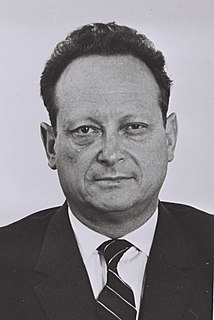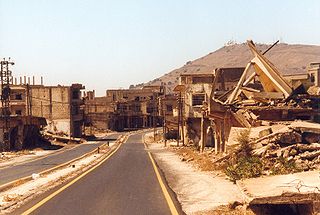Yigal Kipnis | |
|---|---|
 | |
| Born | October 28, 1949 |
| Nationality | Israeli |
Yigal Kipnis (born October 28, 1949) is an Israeli historian and author.
Yigal Kipnis | |
|---|---|
 | |
| Born | October 28, 1949 |
| Nationality | Israeli |
Yigal Kipnis (born October 28, 1949) is an Israeli historian and author.
Yigal Kipnis earned a BSc in civil engineering from the Technion in Haifa (1977), and completed his MA (2003) and PhD (2006) in Land of Israel Studies at Haifa University. He served as a helicopter pilot in the Israeli Air Force for 31 years, of which 26 were in the reserves. Kipnis has lived on Moshav Ma'ale Gamla since 1978. [1]
The Golan Heights: Political History, Settlement and Geography since 1949 (Routledge, 2013): The book presents Kipnis’ research on the settlement landscape in the Golan Heights on the eve of the Six-Day War and documents the rural Jewish settlement process in the Golan following the war, since 1967. Relations between Israel and Syria throughout this period are analyzed. [2] [3]
1973: The Road to War (Just World Books, 2013): [4] [5] The book deals with the circumstances leading to the 1973 war and the public discourse about it. In it, Kipnis reveals documentation of secret channels between US Secretary of State Henry Kissinger and the Israeli prime minister, Golda Meir, and between Kissinger and President Sadat of Egypt. Sadat's peace initiative, supported by President Nixon and Kissinger, was rejected by Israel's prime minister, resulting in the outbreak of the 1973 war. The documentation affirms the central role of political considerations and reduces the role of the intelligence failure when examining the factors leading to war.

The Yom Kippur War, also known as the Ramadan War, the October War, the 1973 Arab–Israeli War, or the Fourth Arab–Israeli War, was an armed conflict fought from 6 to 25 October 1973 between Israel and a coalition of Arab states led by Egypt and Syria. The majority of combat between the two sides took place in the Sinai Peninsula and the Golan Heights—both of which were occupied by Israel in 1967—with some fighting in African Egypt and northern Israel. Egypt's initial objective in the war was to seize a foothold on the eastern bank of the Suez Canal and subsequently leverage these gains to negotiate the return of the rest of the Israeli-occupied Sinai Peninsula.

Muhammad Anwar el-Sadat was an Egyptian politician and military officer who served as the third president of Egypt, from 15 October 1970 until his assassination by fundamentalist army officers on 6 October 1981. Sadat was a senior member of the Free Officers who overthrew King Farouk in the Egyptian Revolution of 1952, and a close confidant of President Gamal Abdel Nasser, under whom he served as Vice President twice and whom he succeeded as president in 1970. In 1978, Sadat and Menachem Begin, Prime Minister of Israel, signed a peace treaty in cooperation with United States President Jimmy Carter, for which they were recognized with the Nobel Peace Prize.

The Camp David Accords were a pair of political agreements signed by Egyptian President Anwar Sadat and Israeli Prime Minister Menachem Begin on 17 September 1978, following twelve days of secret negotiations at Camp David, the country retreat of the President of the United States in Maryland. The two framework agreements were signed at the White House and were witnessed by President Jimmy Carter. The second of these frameworks led directly to the 1979 Egypt–Israel peace treaty. Due to the agreement, Sadat and Begin received the shared 1978 Nobel Peace Prize. The first framework, which dealt with the Palestinian territories, was written without participation of the Palestinians and was condemned by the United Nations.

Yigal Allon was an Israeli politician, commander of the Palmach, and general in the IDF. He served as one of the leaders of Ahdut HaAvoda party and the Israeli Labor party, and acting Prime Minister of Israel. He was a Knesset member and government minister from the third Knesset to the ninth inclusive. Allon died unexpectedly in 1980 after he suffered a cardiac arrest.

Ezer Weizman was the seventh President of Israel, first elected in 1993 and re-elected in 1998. Before the presidency, Weizman was commander of the Israeli Air Force and Minister of Defense.

Quneitra is the largely destroyed and abandoned capital of the Quneitra Governorate in south-western Syria. It is situated in a high valley in the Golan Heights at 1,010 metres (3,313 feet) above sea level. Since 1974, pursuant to United Nations Security Council Resolution 350 and the Agreement on Disengagement between Israel and Syria, the city is inside the UN-patrolled buffer zone.
The Rogers Plan was a framework proposed by United States Secretary of State William P. Rogers to achieve an end to belligerence in the Arab–Israeli conflict following the Six-Day War and the continuing War of Attrition.

The Allon Plan was a plan to partition the West Bank between Israel and the Hashemite Kingdom of Jordan, create a Druze state in the Israeli-occupied Golan Heights, and return most of the Sinai Peninsula to Arab control. The plan was drafted by Israeli Minister Yigal Allon shortly after the Six-Day War in June 1967.

The Golan Heights, or simply the Golan, is a region in the Levant spanning about 1,800 square kilometres (690 sq mi). The region defined as the Golan Heights differs between disciplines: as a geological and biogeographical region, the term refers to a basaltic plateau bordered by the Yarmouk River in the south, the Sea of Galilee and Hula Valley in the west, the Anti-Lebanon with Mount Hermon in the north and Wadi Raqqad in the east. As a geopolitical region, it refers to the border region captured from Syria by Israel during the Six-Day War of 1967; the territory has been occupied by the latter since then and was subject to a de facto Israeli annexation in 1981. This region includes the western two-thirds of the geological Golan Heights and the Israeli-occupied part of Mount Hermon.

Fiq was a Syrian town in the Golan Heights that administratively belonged to Al Quneitra Governorate. It sat at an altitude of 349 meters (1,145 ft) and had a population of 2,800 in 1967. It was the administrative center of the Fiq District, the southern district the Golan. Fiq was evacuated during and after the Six-Day War in June 1967. The Israeli settlement of Kibbutz Afik was built close by.

Ismail Fahmy was an Egyptian diplomat and politician. He served as ambassador to Austria (1968–1971), tourism minister (1973), foreign minister (1973–1977) and deputy prime minister (1975–1977). He was awarded to professorship. He resigned from the government in 1977 to protest Anwar Sadat's visit to Jerusalem. Although he was a supporter and confidant of Sadat, later he became sharply critical of his policies and decision making.
Kfar Haruv is an Israeli settlement organized as a kibbutz located in the southern Golan Heights. A member of the Kibbutz Movement, it falls under the jurisdiction of Golan Regional Council. The international community considers Israeli settlements in the Golan Heights illegal under international law, but the Israeli government disputes this. In 2019 it had a population of 434.

Kanaf is an Israeli settlement and moshav shitufi located in the southern Golan Heights, under the administration of Israel. One of four Golan settlements that overlook the Sea of Galilee, it falls under the jurisdiction of Golan Regional Council. The settlement began to be populated in 1991, and had a population of 461 in 2019.

Nov is an Israeli settlement and religious moshav in the southern Golan Heights, under the administration of Israel. Located to the east of the Sea of Galilee, it falls under the municipal jurisdiction of Golan Regional Council. In 2019 it had a population of 965.

Had Ness is an Israeli settlement organized as a community settlement, in the Golan Heights. Located adjacent to the Jordan River, it falls under the jurisdiction of Golan Regional Council. In 2019 it had a population of 810.

Kela Alon is an Israeli settlement organized as a community settlement, in the Golan Heights. Falling under the municipal jurisdiction of Golan Regional Council, in 2019 it had a population of 319.

Before the Six-Day War and Yom Kippur War, the Golan Heights comprised 312 inhabited areas, including 2 towns, 163 villages, and 108 farms. In 1966, the Syrian population of the Golan Heights was estimated at 147,613. Israel seized about 70% of the Golan Heights in the closing stages of the Six-Day War. Many of these residents fled during the fighting, or were driven out by the Israeli army, and some were evacuated by the Syrian army. A cease-fire line was established and large parts of the region came under Israeli military control, including the town of Quneitra, about 139 villages and 61 farms. Of these, the Census of Population 1967 conducted by the Israeli Defence Forces listed only eight, including Quneitra. One of the remaining populated villages, Shayta, was partially destroyed in 1967 and a military post built in its place. Between 1971–72 it was destroyed completely, with the remaining population forcibly transferred to Mas'ade, another of the populated villages under Israeli control.

Katzrin is an Israeli settlement organized as a local council in the Golan Heights. Known as the "capital of the Golan", it is the second-largest locality there after Majdal Shams, and the largest Israeli settlement. In 2019 it had a population of 7,297. It is the seat of Golan Regional Council.

The Golan Heights are a rocky plateau in Western Asia that was captured by Israel from Syria in the 1967 Six-Day War. The international community recognizes the Golan Heights to be official Syrian territory and widely rejects Israeli military occupation. Following the war, Syria dismissed any negotiations with Israel as part of the Khartoum Resolution.

Annexation of the Jordan Valley is the proposed application of Israeli sovereignty over the Jordan Valley. The idea has been advocated by some Israeli politicians since the Israeli occupation of the West Bank began in 1967, most notably with the Allon Plan and the 2020 Trump peace plan. Israeli prime minister Netanyahu's September 2019 annexation proposal included Jericho becoming a Palestinian enclave.